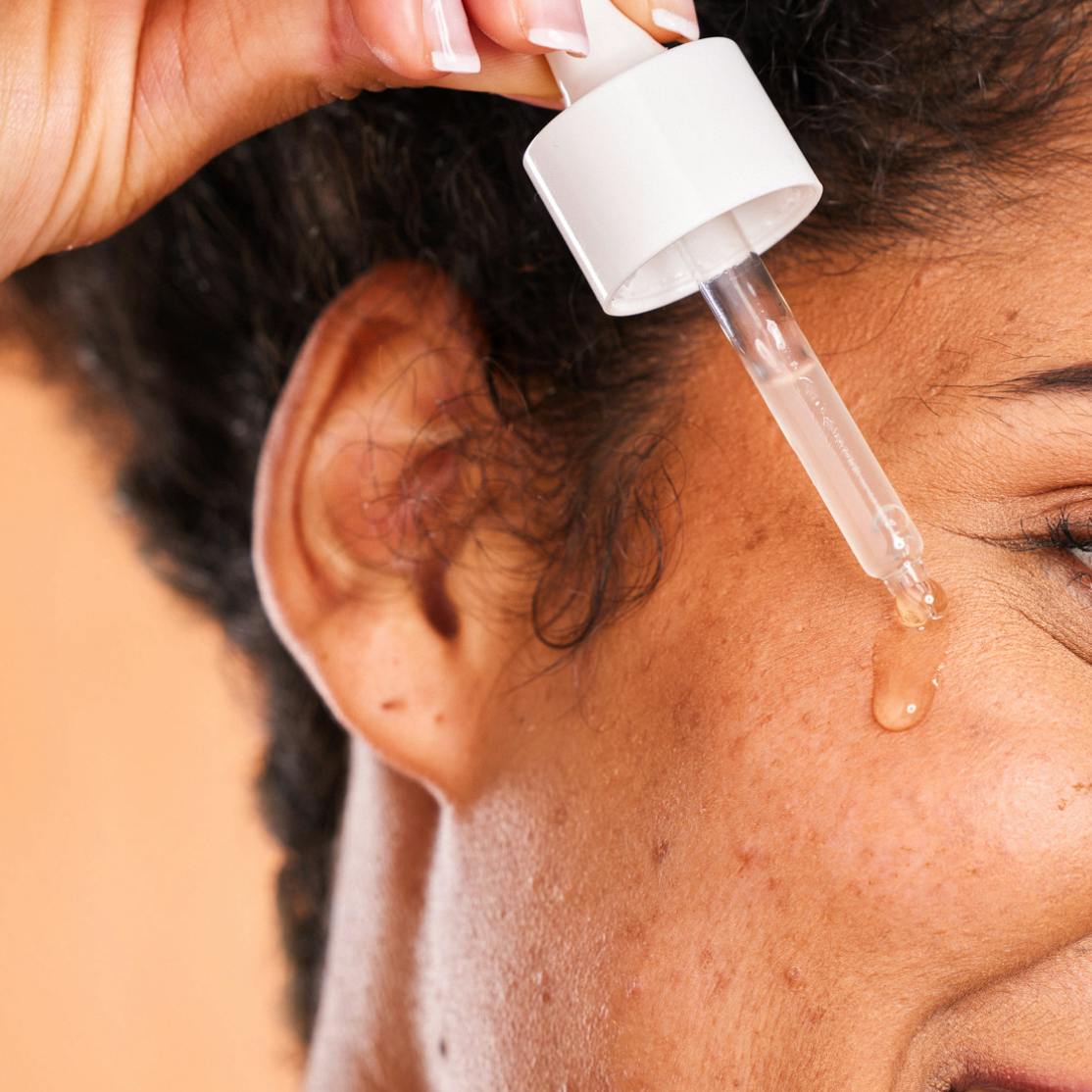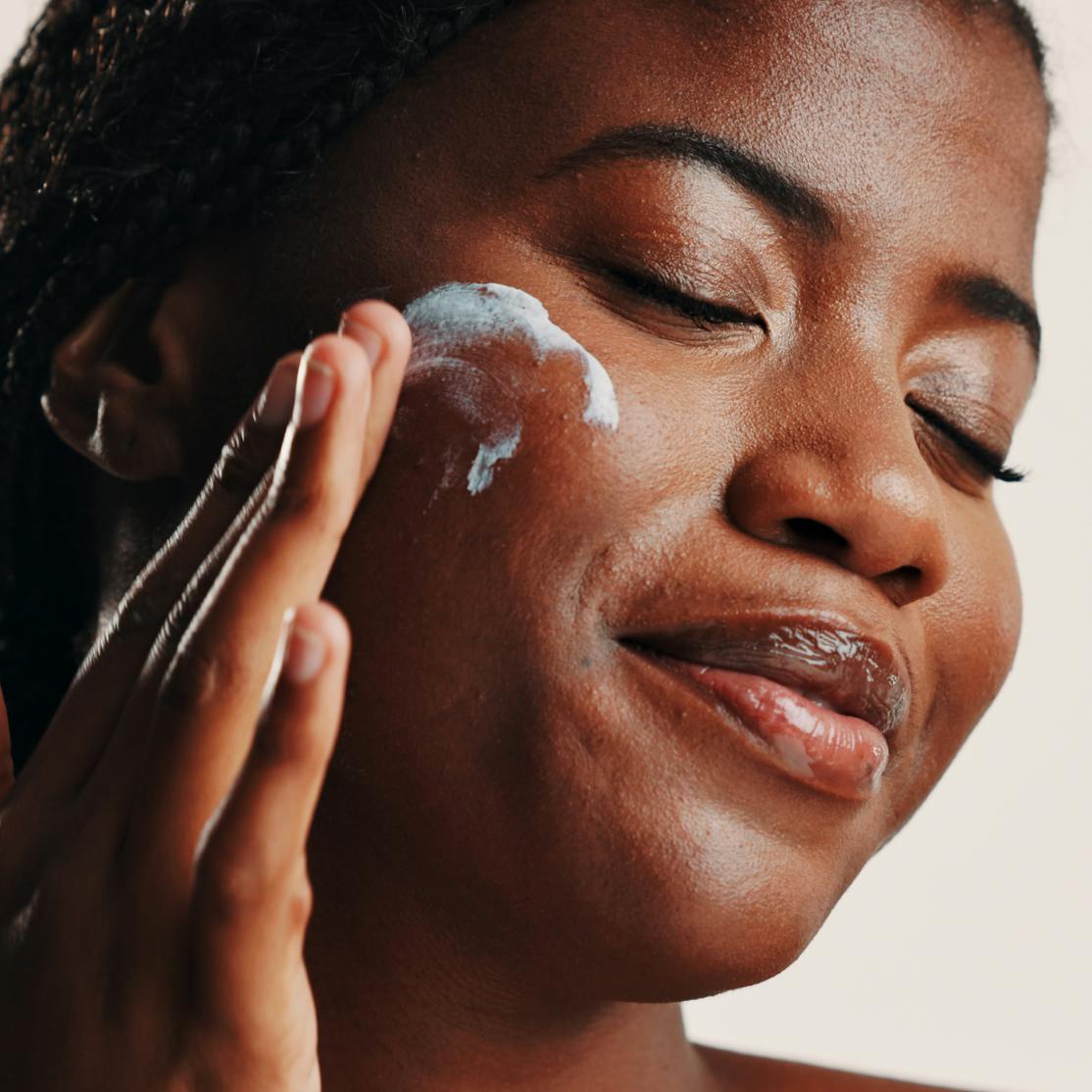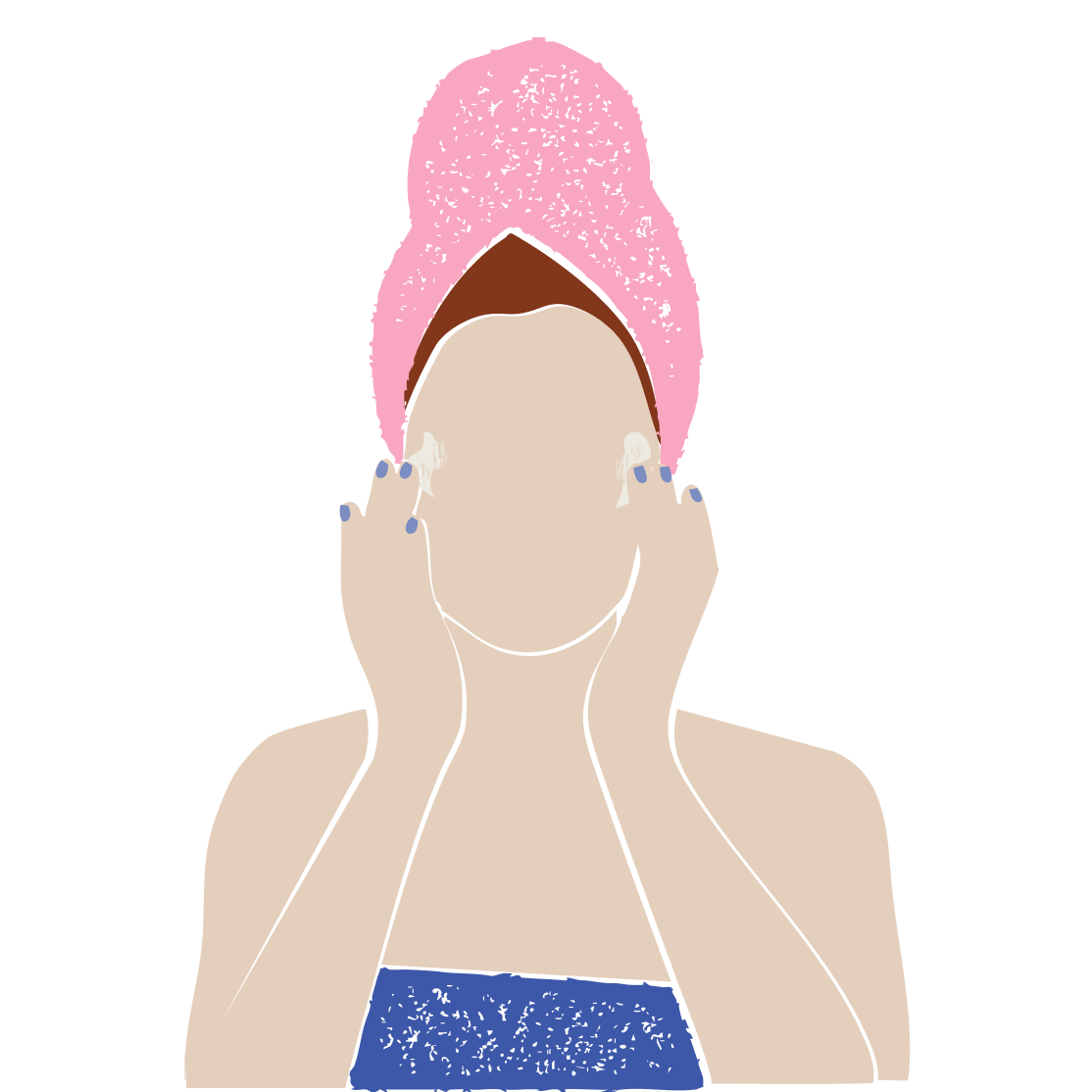Retinol and hyaluronic acid are like apples and oranges: Both ingredients are very good for you, yet they are very different. While retinol is the gold standard anti-ager proven to help firm skin and soften fine lines (among many other things), hyaluronic acid is a super-hydrator for dry skin. And, together, they can be a powerful skincare combo, particularly for women during perimenopause and menopause when skin loses collagen, elastin, and lubrication, leading to thinning, sagging, wrinkles, and dryness. And don’t think you need to troubleshoot on your own. Working with a dermatologist or menopause specialist, like a Midi clinician, can help you choose the right treatments sooner with less trial and error.
Retinol and hyaluronic acid (HA) are two active ingredients that work as a dynamic duo for your skin. It’s no wonder that many retinol creams contain HA in the formula to help increase hydration. When it comes to the best moisturizers for aging skin, or perimenopause skin, or for anyone who’s proactive about counteracting wrinkles, laxity, dullness, or dryness, these two ingredients are skincare superheroes.
Since the production of natural hyaluronic acid, collagen, and elastin in the skin diminishes over time, these ingredients are essential parts of a healthy routine for women during perimenopause and menopause. So, when it comes to retinol vs hyaluronic acid, how do you choose between them? The answer: You don’t have to. They make a truly effective team. Read on to learn the difference between hyaluronic acid, a humectant that attracts moisture to the skin, and retinol, which stimulates collagen and elastin production to help firm and smooth the complexion.
What Is Retinol?
Retinol is a chemical derivative of vitamin A. It’s a milder over-the-counter analog of prescription retinoids like tretinoin. Retinol is an established gold standard topical ingredient, proven to help improve skin issues related to menopause and aging—everything from laxity to fine lines and adult acne breakouts—by improving skin cell turnover and collagen production.
What Is Hyaluronic Acid?
Hyaluronic acid (HA) is a naturally occurring lubricating substance in the skin—not to mention other areas of the body including your eyes and joints. Research shows that the production of natural HA in the skin decreases starting as early as age 25, so it should be a key component in your skincare routine if dry skin is a main issue (and it’s all too common during perimenopause). Another perk: As topical hyaluronic acid not only hydrates the surface of the skin, it also instantly plumps and softens fine lines—similar to how a sponge puffs up as it draws in moisture.
Key Differences Between Retinol and Hyaluronic Acid

Mechanisms of action
Retinol and retinoids like tretinoin work by interacting with receptors inside skin cells to help regulate healthy skin cell turnover, which starts to slow down as early as your 30s. (Skin cell turnover is the natural shedding of dead keratin from the surface as they’re replaced with fresh new cells.) It also stimulates collagen and elastin production, ultimately increasing volume and firmness and softening fine lines.
Retinol is converted into retinoic acid in the body, so it’s a little bit more indirect and less potent than a retinoid, but still proven to be very effective, although the benefits are more gradual.
Hyaluronic acid (HA) is water-binding humectant, which means that it attracts moisture to the surface of the skin. It’s a super soaker ingredient that instantly plumps, soothes, and moisturizes parched skin with intense hydration.
Usage and Application
Retinol is recommended for nighttime use because the ingredient tends to make the skin photosensitive, which means it can make the skin more prone to sun damage and make the retinol less effective. This is why wearing a broad-spectrum sunscreen every day is vital when you’re using a retinol in your skincare regimen. Retinol is a potent active ingredient, so a little goes a long way. Use a dime-size amount for the face and neck.
Hyaluronic acid can be used day and night, whether the ingredient is contained in a serum or a lotion or cream. Remember, this ingredient acts as a drink of water for your thirsty skin, so you can slather it on. It can also be used underneath, or on top of a retinol product to hydrate the skin.
Skin Type Compatibility
Retinol works well for all skin types, but it’s especially efficacious for treating—and proactively addressing—skin concerns such as hyperpigmentation, fine lines, and skin laxity. It’s also clinically proven to help keep acne-prone skin clear (remember, it was first an acne medication).
Hyaluronic acid is safe and suitable for all skin types, and this hydrating superhero is particularly important if you tend to have skin that’s consistently on the drier side.
Potential Side Effects
Retinoids—whether OTC or Rx—can be irritating for sensitive skin types. It can cause redness, flaking, and dryness, which is why dermatologists recommend starting gradually. Apply a retinol product two nights a week and then work up to every other night as your skin begins to tolerate it. Redness, peeling, flaking, and dryness will gradually improve as your skin adjusts to the product.
Hyaluronic acid, on the other hand, is considered generally safe for all skin types. Don’t let the word “acid” fool you, this ultra-gentle ingredient doesn’t exfoliate or irritate the skin, so it’s safe for even the most sensitive complexions.
Combining Retinol and Hyaluronic Acid: The Retinol Sandwich Method
If you’re wondering if you can use retinol and HA together, the answer is a resounding yes. An HA serum can help to mitigate potential side effects of retinol (namely dryness) if you apply it underneath, and layering a moisturizing cream on top can go even further to prevent its drying effects. This retinol sandwiching technique is recommended by many dermatologists to replenish hydration and prevent irritation.
How Perimenopause and Menopause Affect Your Skin
During perimenopause, the decrease of estrogen contributes to the decrease of collagen and elastin. Estrogen hormones stimulate skin cells to get into action and make more of these proteins, and studies show that collagen can decrease by 30% in the five years following menopause. “When collagen drops, we see changes in skin firmness, hydration, and even wound healing,” says Kathleen Jordan, MD, Midi’s Chief Medical Officer. That’s why it’s important to be proactive about hydrating your skin as well as boosting collagen and elastin, especially if you’re 40+.
Other Skincare Solutions: Topical Estriol Cream
Retinol and hyaluronic acid should be mainstays in your skincare regimen but they aren’t your only options. Topical estrogen (estriol) is a prescription-strength product that has been shown to improve collagen and elastin levels in menopausal women, as well as moisturizing the skin without significantly increasing systemic hormone levels. Midi’s Custom Rx formulation also contains hyaluronic acid so you’re getting a boost of hydration, too.
When applied to the face, estriol can help minimize fine lines, and plump and tighten skin. More research is needed, but one small study found that topical estriol can increase skin firmness by up to 61% and skin hydration by 38% after just 16 weeks of use. In another study of 59 women, six months of use led to marked improvement in wrinkle depth and pore sizes. “Topical estrogen has been shown to increase collagen by 33% to 50%, improving skin elasticity and reducing wrinkles,” says Dr. Jordan.
True Stories of Transformation
Key Takeaways
- Hyaluronic acid, a humectant that attracts moisture to the skin, is an essential hydrating ingredient for all skin types and all ages.
- Retinol is an established gold standard active ingredient that has multiple benefits, including regulating skin cell turnover to keep pores clear and prevent adult acne breakouts. By amping up sluggish cell turnover, retinol also counters dull skin and dark spots.
- Hyaluronic acid (HA) and retinol work better together since one of retinol’s potential side effects can be dryness, which hydrating HA can help mitigate.
- Consider retinol sandwiching: Layer a HA serum underneath a retinol product, then apply a hyaluronic acid-based moisturizer to lock it all in.
Frequently Asked Questions (FAQs)
Is it better to use retinol or hyaluronic acid?
When it comes to retinol and hyaluronic acid, one isn’t better than the other. They both have important ingredients for menopausal skin, but they do different things so it pays to use both. Hyaluronic acid is a hydrating humectant that helps add moisture to skin. Retinol helps to regulate sluggish skin cell turnover, which in turn improves texture and works to even the skin tone and keep pores clear. It also boosts the production of collagen and elastin, those precious proteins responsible for skin firmness and elasticity.
Can I apply hyaluronic acid and retinol together?
Absolutely! The TikTok trend of retinol sandwiching technique really works to keep irritation and dryness from retinol at bay. You can apply an HA serum underneath a retinol product, and you could also layer a hyaluronic acid lotion or cream on top to add more moisture. It won’t dilute the potency of the retinol ingredient.
At what age should I start using a retinol?
If you’re in your 30s, it’s not too early to use a retinol product proactively. The fact is, from your mid-20s onward, your skin will lose about 1% of its collagen each year. Estrogen starts to seriously decrease during perimenopause and that causes a decrease in both collagen and elastin. The timing of perimenopause is unique for everyone, and while it typically starts in your 40s, it can begin for some women in their 30s. By the time you turn 40, it’s prime time to start on a retinol or a prescription retinoid to counter everything from slow skin cell turnover to collagen depletion.
Is hyaluronic acid better than retinol for under the eyes?
Yes, hyaluronic acid is better than retinol for under the eyes because retinol can be irritating to the delicate eye area. Hyaluronic acid in an eye cream (and it’s a common hydrating ingredient in many of them) is a multi-tasking winner since it moisturizes and plumps the thin skin under the eyes to minimize the appearance of crow’s feet and undereye hollowness.
Which is better with retinol: niacinamide or hyaluronic acid?
Both niacinamide and hyaluronic acid are excellent (and non-irritating) hydrating ingredients, and using both with retinol is better than sticking to just one. Many lotions and serums will contain both so look at the ingredients list to make sure. Hyaluronic acid and niacinamide help to replenish the decreased hydration in your skin barrier. Studies suggest that hyaluronic acid can effectively penetrate the skin to potentially replenish HA levels. Niacinamide has been proven to increase hydration in the upper levels of the skin, as well as having anti-inflammatory and antioxidant properties to calm sensitive skin and help defend against collagen degradation.
If you’re in perimenopause or menopause and want guidance from clinicians who specialize in women’s midlife health, book a virtual visit with Midi today.
Hormonal change is at the root of dozens of symptoms women experience in the years before and after their period stops.
Our trained menopause specialists can help you connect the dots to guide you towards safe, effective solutions.
Whether you need personalized guidance or a prescription routine to tackle symptoms—including vaginal dryness and irritation, brain fog, hot flashes, sleep trouble, mood swings, and weight gain—we’ve got you covered.
Midi’s mission is to revolutionize healthcare for women at midlife, wherever they live and whatever their health story. We believe that starts with education, to help all of us understand our always-changing bodies and health needs. Our core values guide everything we do, including standards that ensure the quality and trustworthiness of our content and editorial processes. We’re committed to providing information that is up-to-date, accurate, and relies on evidence-based research and peer-reviewed journals. For more details on our editorial process, see here.







